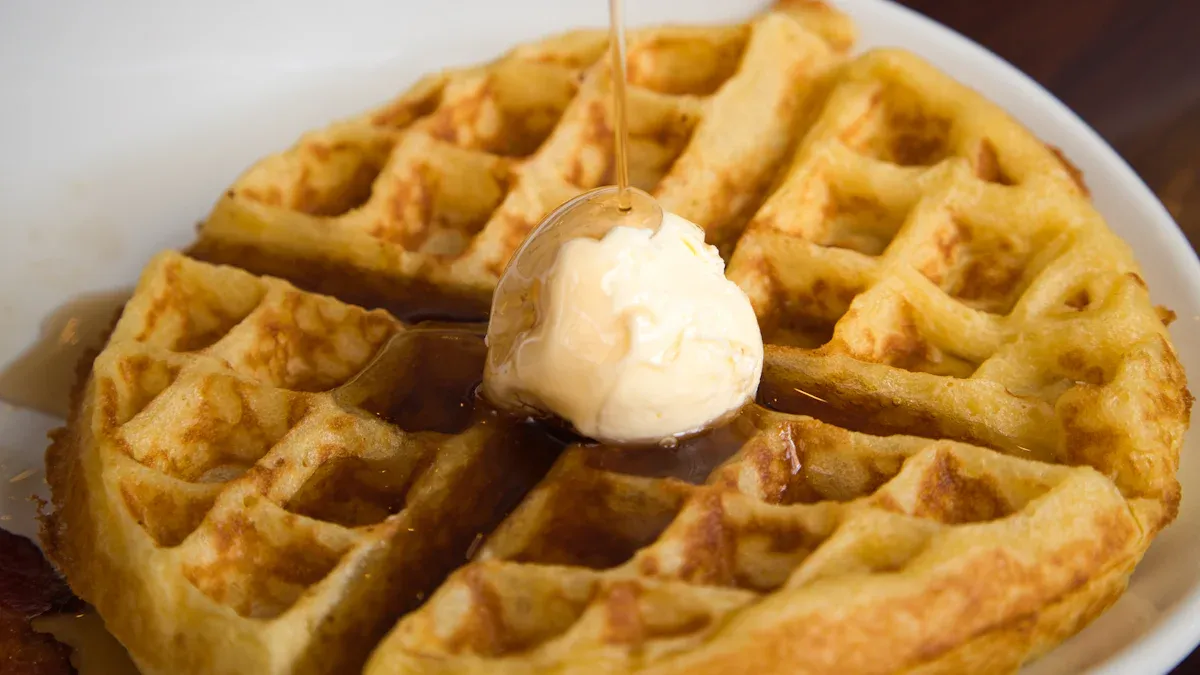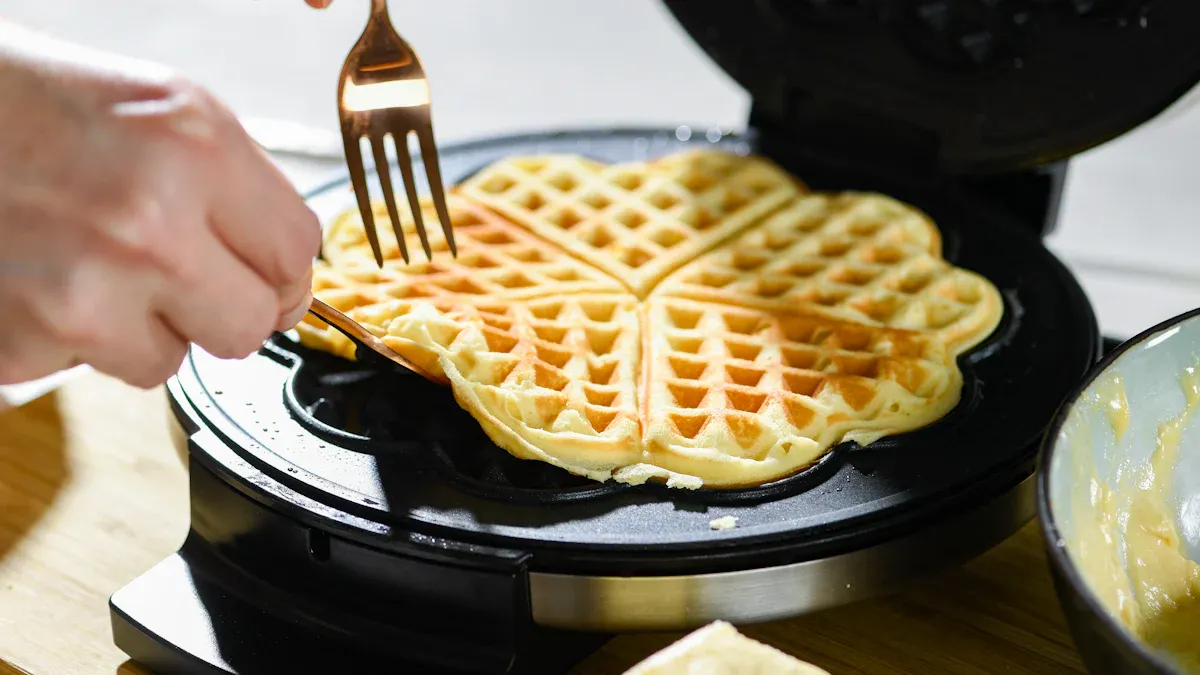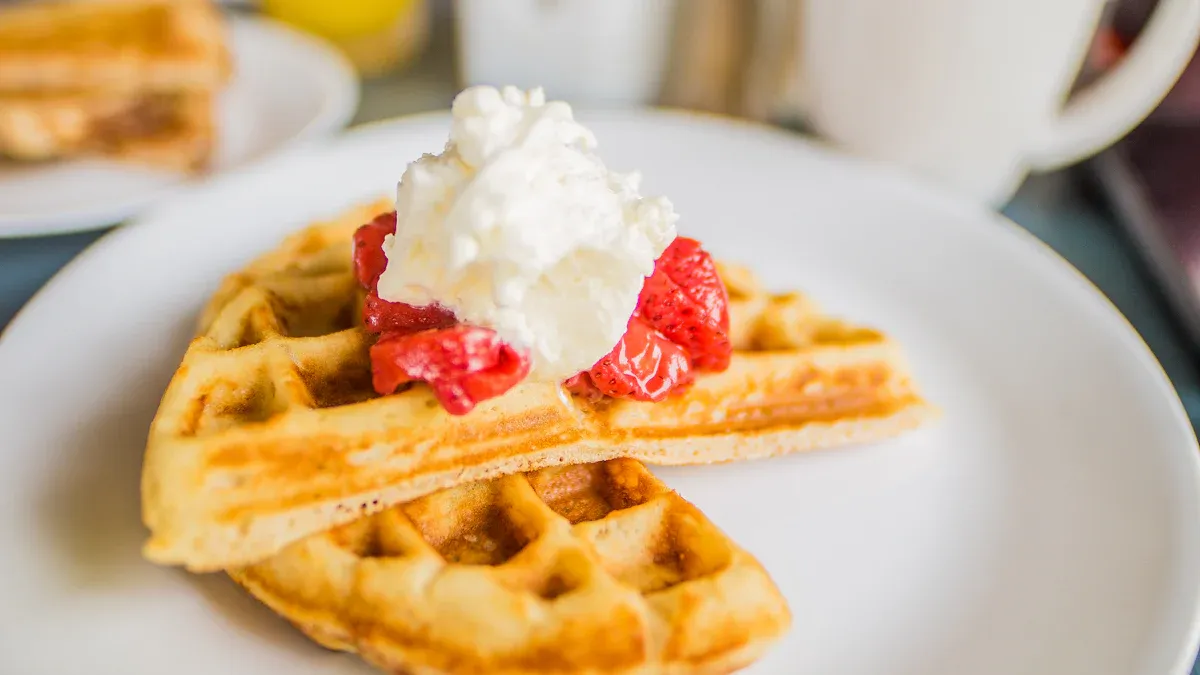
A Belgian waffle maker is a specialized kitchen appliance designed to create thick, fluffy waffles with deep pockets. Its user-friendly design makes it ideal for beginners who want consistent results without hassle. Belgian waffles stand out for their airy texture and ability to hold toppings like syrup or fruit, offering a delightful breakfast experience.
Key Takeaways
- Belgian waffle makers have different types like rotating, electric, and stovetop. Pick one that matches how you cook and your kitchen space.
- Check for important features like non-stick coating and temperature settings. These make it easier to cook waffles perfectly.
- Cleaning and taking care of your waffle maker helps it last longer. Clean it gently and store it properly to keep it working well.
Types of Belgian Waffle Makers

Belgian waffle makers come in various designs, each catering to different needs and preferences. Understanding the types available can help users choose the best option for their kitchen.
Rotating Belgian waffle makers
Rotating Belgian waffle makers are designed to evenly distribute batter across the cooking plates. This ensures consistent browning and a uniform texture. The rotating mechanism flips the waffle maker during cooking, allowing gravity to spread the batter evenly.
Tip: Rotating waffle makers are ideal for users who prioritize perfectly cooked waffles with minimal effort.
Some models, like the Crux Double Rotating Belgian Waffle Maker, excel in operational efficiency. They produce evenly browned waffles, showcasing the advantages of their rotating design. Additionally, the Crux Belgian Waffle Maker features a simple control panel, making it beginner-friendly.
Electric Belgian waffle makers
Electric Belgian waffle makers are the most popular choice for home kitchens. They offer convenience and versatility, with features like adjustable temperature controls and non-stick surfaces. These appliances plug directly into a power source, eliminating the need for external heat.
| Brand | Description | Trust Level |
|---|---|---|
| Cuisinart | Known for high-quality, versatile products with even heat distribution. | Advocates |
| Black+Decker | Reliable, user-friendly products with adjustable temperature control. | Advocates |
| Hamilton Beach | Offers great performance at a budget-friendly price. | Advocates |
| Oster | Known for sleek design and durable construction. | Advocates |
| Proctor Silex | Focused on providing simple and reliable kitchen solutions. | Advocates |
| Presto | Recognized for delivering efficient, straightforward products. | Advocates |
Electric waffle makers are favored for their reliability and ease of use. Brands like Cuisinart and Black+Decker are trusted for their consistent performance and user-friendly features.
Stovetop Belgian waffle makers
Stovetop Belgian waffle makers offer a traditional approach to waffle-making. These models require an external heat source, such as a gas or electric stove. They are typically made from durable materials like cast iron or aluminum.
| Model | Material | Size | Weight | Waffle Type | Price | Rating |
|---|---|---|---|---|---|---|
| Nordic Ware | Cast Aluminum | 17" x 8" x 2" | 2.7 lbs | Belgian Waffle | $ | 4.3 |
| UH-CI194 | Cast Iron | 12.1" x 7.5" x 1.5" | 7 lbs | American Waffle | $$ | 4.0 |
| Rome Waffle Iron | Cast Iron | 6.75" x 10" x 1" | 4 lbs | American Waffles | $ | 3.8 |
Advantages of stovetop waffle makers include their portability and suitability for camping. They do not require electricity, making them versatile for outdoor use. However, they may not work on all stovetop surfaces, and their handles can become extremely hot during use.
Note: Stovetop waffle makers require a learning curve to achieve perfect waffles, but they offer a unique cooking experience for enthusiasts.
Key Features of a Belgian Waffle Maker
Non-stick coating
A non-stick coating is essential for any Belgian waffle maker. It prevents batter from sticking to the plates, ensuring waffles release effortlessly. This feature also reduces the need for excessive oil or butter, promoting healthier cooking. Additionally, non-stick surfaces distribute heat evenly, preventing burnt edges or undercooked centers. Users can enjoy perfectly golden waffles with minimal effort.
Tip: To maintain the non-stick surface, avoid using metal utensils that may scratch the coating.
Adjustable temperature control
Adjustable temperature control allows users to customize the cooking process. Most Belgian waffle makers offer temperature ranges between 330°F and 400°F (165°C to 205°C). This feature ensures precise cooking by maintaining consistent heat throughout the baking cycle. A temperature sensing unit detects drops when batter is added and adjusts the heat accordingly. This level of control helps users achieve their preferred waffle texture, from soft and fluffy to crispy and golden.
Size and capacity
The size and capacity of a Belgian waffle maker determine its suitability for different households. Compact models are ideal for small kitchens, while larger ones cater to families or gatherings. The market for waffle makers is growing, with an expected value of $322.65 million by 2030, reflecting their increasing popularity. Choosing the right size ensures efficient use of space and meets individual needs.
Ease of cleaning
Modern Belgian waffle makers prioritize ease of cleaning. Non-stick surfaces simplify the process by preventing batter residue from sticking. Many models feature removable plates that can be hand-washed or placed in a dishwasher. Using cooking spray further enhances cleaning efficiency. These features save time and effort, making waffle-making a hassle-free experience.
Additional features to consider
Additional features enhance the functionality and versatility of Belgian waffle makers. Interchangeable plates allow users to switch between waffles and pancakes. A 180° flip function ensures even cooking, while a removable drip tray catches spills for easy cleanup. Other features, such as vertical designs for space-saving and chef-curated recipe guides, add convenience and creativity to the waffle-making process.
Note: Features like locking buckles and durable stainless steel builds improve safety and longevity, making them valuable additions.
How to Use a Belgian Waffle Maker

Preparing the waffle maker
Proper preparation ensures consistent results and prevents sticking. Start by plugging in the waffle maker and pressing the power button. Allow it to preheat until the ready-to-use indicator light turns on. This step ensures the plates reach the optimal cooking temperature. For non-stick surfaces, lightly spray the plates with a nonstick cooking spray or brush them with a thin layer of oil. Avoid using excessive oil, as it can affect the waffle’s texture.
Tip: Always read the instruction manual for your specific model to understand its preheating process and safety guidelines.
Mixing and pouring the batter
The batter plays a crucial role in achieving the perfect Belgian waffle. Begin by combining warm milk and melted butter, then let the mixture cool slightly. Add yeast, sugar, salt, flour, and eggs to create a smooth batter. For a lighter texture, whip the egg whites separately and fold them into the mixture. Allow the batter to rise overnight in the refrigerator for enhanced flavor and texture.
Once the batter is ready, pour approximately ½ cup onto the center of the preheated waffle maker. Use a ladle or measuring cup for accuracy. Spread the batter evenly across the plates if necessary. For rotating waffle makers, flip the plates immediately after pouring to ensure even distribution.
Note: Avoid overfilling the plates, as excess batter can spill out during cooking.
Cooking the waffles
Cooking requires attention to timing and temperature. Preheat the waffle maker to around 300°F (150°C) for optimal results. Close the lid after pouring the batter and monitor the steam. Steam indicates that the waffle is still cooking. Wait until the steam dissipates completely before opening the lid. This ensures the waffle is fully cooked and prevents tearing.
Most Belgian waffles take 4–6 minutes to cook, depending on the machine and batter consistency. Use the built-in indicator light or timer, if available, to determine when the waffle is ready. For yeast-based batters, letting the mixture sit for an hour before cooking can improve texture and yield.
Tip: Adjust the temperature settings to achieve your preferred level of crispiness.
Cleaning after use
Cleaning the waffle maker immediately after use prevents batter residue from hardening. Allow the appliance to cool completely before starting the cleaning process. For non-removable plates, mix hot water with dish soap and pour it over the plates. Let the solution sit for about a minute to loosen stuck batter and crumbs. Wipe the plates with a soft cloth or sponge.
For models with removable plates, detach them and wash them with warm, soapy water. Some plates are dishwasher-safe, but always check the manufacturer’s instructions. Clean the exterior with a damp cloth to remove any spills or grease.
Note: Avoid using abrasive sponges or metal utensils, as they can damage the non-stick coating.
Tips for Choosing the Right Belgian Waffle Maker
Matching features to your needs
Selecting the right Belgian waffle maker begins with identifying the features that align with your cooking preferences. Some models excel in even browning, while others offer multiple color range settings for customized results. Features like adjustable temperature controls and nonstick grates simplify the cooking process. Dishwasher-safe parts and intuitive controls enhance convenience, making them ideal for first-time users.
Tip: Prioritize models with user-friendly indicators and adjustable settings to achieve consistent waffles every time.
Budget considerations
Budget plays a significant role in choosing a waffle maker. High-end models often include advanced features like interchangeable plates and precise browning levels. Mid-range options balance affordability and functionality, offering reliable performance without unnecessary extras. Budget-friendly models focus on simplicity, providing essential features like nonstick surfaces and basic temperature controls.
- Key factors to consider:
- Price range: $30–$150
- Features included: Adjustable settings, ease of cleaning
- Long-term durability
Investing in a model that meets your needs ensures value for money without compromising quality.
Space and storage
Kitchen space often dictates the size and design of a waffle maker. Compact models fit small countertops and are easy to store, while larger units cater to families or frequent use. Vertical designs save space and reduce clutter, making them suitable for tight kitchens.
Note: Consider models with foldable handles or cord storage for added convenience.
Brand reputation
Trusted brands offer reliability and consistent performance. Consumer reviews highlight factors like ease of use, even browning, and cleaning efficiency. Brands like Cuisinart and Hamilton Beach consistently receive high ratings for their durable construction and user-friendly features.
- Top-rated features in reviews:
- Ability to brown evenly
- Multiple browning levels
- Convenient controls and indicators
Choosing a reputable brand ensures peace of mind and long-term satisfaction with your Belgian waffle maker.
Maintenance and Cleaning
Cleaning non-stick surfaces
Maintaining the non-stick coating of a Belgian waffle maker ensures optimal performance and longevity. Users should avoid abrasive sponges or metal utensils that can scratch the surface. After cooking, allow the appliance to cool slightly before cleaning. A damp cloth or sponge effectively removes grease and crumbs without damaging the coating. For stubborn residue, a mixture of warm water and mild dish soap loosens debris. Regular cleaning prevents buildup and preserves the non-stick properties, ensuring waffles release effortlessly every time.
Removing batter residue
Removing batter residue requires careful attention to avoid damaging the waffle maker. Several techniques simplify this process:
- Let the waffle maker cool slightly; cleaning is easier when warm but not hot.
- Use a clean pastry brush to sweep away crumbs and wipe down with a damp paper towel.
- Steam clean by placing damp paper towels inside the waffle maker and closing the lid to utilize residual heat.
- Spot-clean stubborn areas with a Q-tip dipped in soapy water.
- Use a toothpick for tight crevices or exterior grime.
- Wipe fixed parts with a damp paper towel, avoiding excessive moisture.
Measuring batter accurately and adding more fat to the recipe can prevent sticking, reducing cleanup time.
Proper storage
Proper storage extends the usability of both the waffle maker and the waffles it produces. Follow these guidelines for optimal results:
- Refrigerate waffles within two hours of cooking to prevent bacteria growth.
- Place waffles in an airtight bag or container to maintain freshness.
- Consume waffles within two to three days for the best taste and texture.
- Freeze waffles for long-term storage, ensuring they are cooled before freezing to preserve quality.
For the waffle maker, store it in a dry, cool place. Models with foldable handles or cord storage optimize space in smaller kitchens.
Extending the lifespan of your waffle maker
Durability testing highlights the importance of proper care in extending the lifespan of a Belgian waffle maker. High-quality models, such as the Great Belgian Waffle Iron, feature robust construction and efficient heat recovery, ensuring consistent performance over time. Regular cleaning, avoiding abrasive tools, and storing the appliance correctly contribute to its longevity. Manufacturers often include warranties that cover materials and workmanship, reflecting their commitment to durability. By following maintenance guidelines, users can enjoy reliable waffle-making for years.
Belgian waffle makers simplify the process of creating delicious, fluffy waffles at home. Their user-friendly features, such as non-stick surfaces and adjustable temperature controls, make them ideal for beginners. Starting this culinary journey allows individuals to explore creativity in breakfast preparation. Making Belgian waffles at home brings joy and satisfaction to any kitchen.
FAQ
What is the difference between Belgian waffles and regular waffles?
Belgian waffles are thicker, with deeper pockets, making them ideal for holding toppings. Regular waffles are thinner and have a denser texture.
Can I use pancake batter in a Belgian waffle maker?
Yes, but the texture may differ. Pancake batter lacks the yeast or whipped egg whites typically found in waffle recipes, resulting in less fluffiness.
How do I prevent waffles from sticking to the plates?
Ensure the plates are preheated and lightly greased. Avoid overfilling the plates, and clean the waffle maker thoroughly after each use to maintain its non-stick surface.

